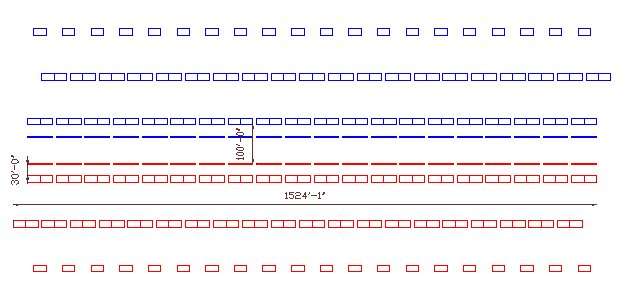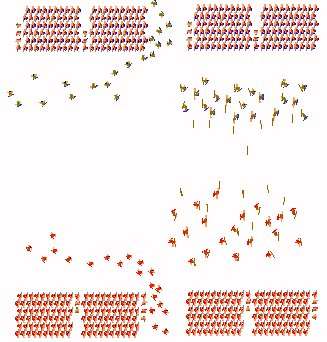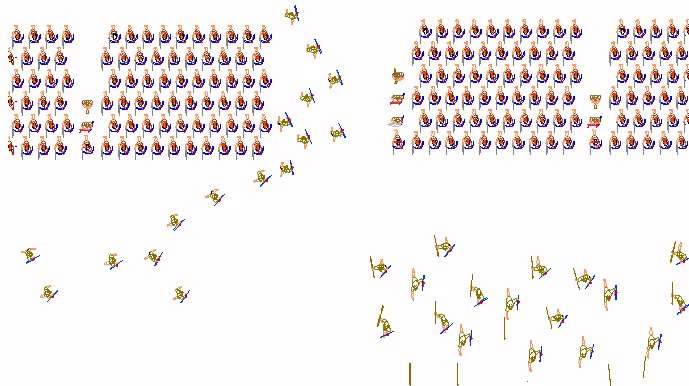The Republican army’s skirmish position
The following schematic shows two pre-Marian armies of four legions each with thin lines of skirmishers deployed in front of each army. In the early pre-Marian legion the auxiliaries used were velites who were armed with short spears or darts. The range for a hand thrown missile weapon could not have been great. The skirmishers are placed 9m (30') in front of their respective armies and about 20m (67') from the opposing skirmishers. This places them close enough to their front lines to be protected and far enough from enemy skirmishers to avoid unnecessary casualties. With an average range of 36m (120') most of the javelins would reach the opposing front line. From the velites, the first rank of the enemy line would be 31m (103') away, the last rank would be as much as 150 feet away, probably within the range of the strongest velites. The two armies are only 133’ apart, barely enough for them to mount a good charge. At a run, the could close the distance between them in ten seconds.
The skirmishers are placed 9m (30') in front of their respective armies and about 20m (67') from the opposing skirmishers. This places them close enough to their front lines to be protected and far enough from enemy skirmishers to avoid unnecessary casualties. With an average range of 36m (120') most of the javelins would reach the opposing front line. From the velites, the first rank of the enemy line would be 31m (103') away, the last rank would be as much as 150 feet away, probably within the range of the strongest velites. The two armies are only 133’ apart, barely enough for them to mount a good charge. At a run, the could close the distance between them in ten seconds.
 The drawing on the left is a detail of the skirmish position showing four centuries on each side. The skirmishers on the left are depicted in the act of withdrawing through the 17 foot gaps between the maniples. The skirmishers on the right are depicted in various fighting poses. The distance between opposing skirmishers is only 37 feet. This seems close but the distance from the foremost skirmisher to the first rank of the maniple is 87 feet. From the skirmishers at the back to the first rank is 117 feet and from them to the back rank is 132 feet. With an average range of only about 120 feet, if the skirmishers were much further apart they would not be within effective range of the opposing troops.
The drawing on the left is a detail of the skirmish position showing four centuries on each side. The skirmishers on the left are depicted in the act of withdrawing through the 17 foot gaps between the maniples. The skirmishers on the right are depicted in various fighting poses. The distance between opposing skirmishers is only 37 feet. This seems close but the distance from the foremost skirmisher to the first rank of the maniple is 87 feet. From the skirmishers at the back to the first rank is 117 feet and from them to the back rank is 132 feet. With an average range of only about 120 feet, if the skirmishers were much further apart they would not be within effective range of the opposing troops.
The drawing below is a detail showing the 17 foot gap between maniples. The gap could probably be smaller, perhaps 10’, and still provide enough room. It also gives a better feel for the relationship of the skirmishers to the main body of troops.

